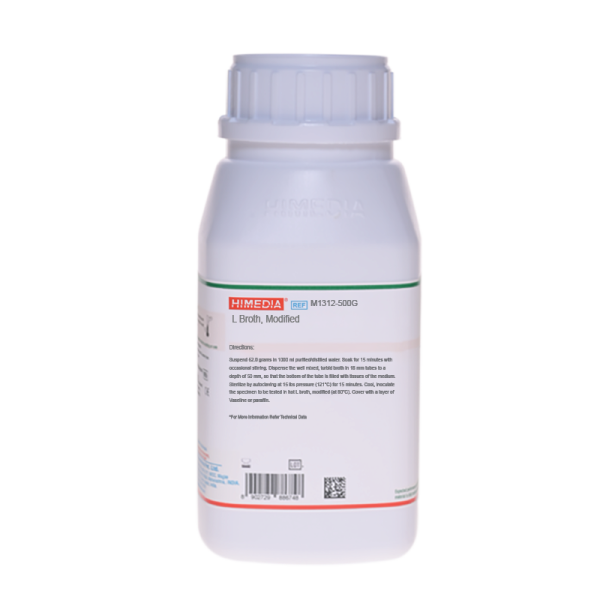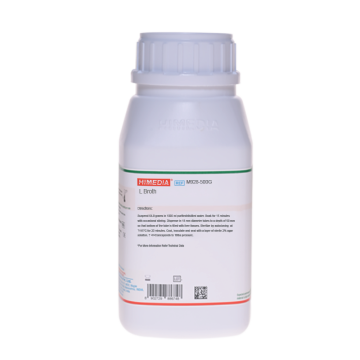 Your enquiry has been submitted
Your enquiry has been submitted
L Broth, Modified (Liver Broth, Modified)
Intended Use:
Used as a presumptive test and for the enrichment of Clostridia and other anaerobes from meat, foodstuffs, clinical samples and other materials.
Composition**
| Ingredients | g/L |
|---|---|
| HL granules # | 50.000 |
| Dextrose (Glucose) | 10.000 |
| Disodium hydrogen phosphate | 2.000 |
Final pH (at 25°C): 7.6±0.2
**Formula adjusted, standardized to suit performance parameters
# Equivalent to Liver granules
Directions
Suspend 62.0 grams in 1000 ml purified/distilled water. Soak for 15 minutes with occassional stirring. Dispense the well-mixed, turbid broth in 18 mm tubes to a depth of 50 mm, so that the bottom of the tube is filled with HL granules. Sterilize by autoclaving at 15 lbs pressure (121°C) for 15 minutes. Cool, inoculate the specimen to be tested in hot L broth, modified (at 80°C). Cover with a layer of Vaseline or paraffin.
Principle And Interpretation
Clostridial species are one of the major causes of food poisoning / gastro-intestinal illnesses. Among the family, Clostridium perfringens is commonly found in wound infections and diarrhea cases. The major virulence factor of C. perfringens is the CPE enterotoxin, which is secreted upon invasion of the host gut, and contributes to food poisoning and other gastrointestinal illnesses (1).
HL granules & dextrose provide the nitrogen, amino acids, vitamins and carbon sources. Disodium hydrogen phosphate buffers the medium. Bundesanstalt initiated the development of liver granules to prepare culture for Fleischforschung (2). For testing sample using L Broth, Modified, immerse a small piece of the material to be tested in hot L Broth (appox. 80°C) and cover with a layer of sterilized paraffin. Incubate for 18-24 hours at 37°C. Gas production indicates that clostridia are probably present.
Type of specimen
Clinical samples -Swab of wounds, pus, etc.; Food samples
Specimen Collection and Handling
For clinical samples follow appropriate techniques for handling specimens as per established guidelines (3,4).
For food samples, follow appropriate techniques for sample collection and processing as per guidelines (5).
After use, contaminated materials must be sterilized by autoclaving before discarding.
Warning and Precautions
In Vitro diagnostic Use. For professional use only. Read the label before opening the container. Wear protective gloves/protective clothing/eye protection/face protection. Follow good microbiological lab practices while handling specimens and culture. Standard precautions as per established guidelines should be followed while handling clinical specimens. Safety guidelines may be referred in individual safety data sheets.
Limitations
- Some strains might show poor growth due to variations in nutritional requirements.
- Further biochemical and serological testing is required for complete identification.
Performance and Evaluation
Performance of the medium is expected when used as per the direction on the label within the expiry period when stored at recommended temperature.
Quality Control
Appearance
Brown coloured granules.
Colour and Clarity of prepared medium
Medium amber coloured, clear to slightly opalescent supernatent over insoluble granules
Reaction
Reaction of 6.2% w/v aqueous solution at 25°C. pH: 7.6±0.2
pH
7.40-7.80
Cultural Response
Cultural characteristics observed after an incubation at 35-37°C for 18-24 hours (for Clostridium species incubate anaerobically).
| Organism | Inoculum (CFU) | Growth | Gas production |
|---|---|---|---|
| Clostridium perfringens ATCC 10543 (00174*) | 50-100 | good | positive reaction |
| Clostridium sporogenes ATCC 11437 | 50-100 | good | positive reaction |
| Escherichia coli ATCC 25922 (00013*) | 50-100 | good | negative reaction |
| Staphylococcus aureus subsp. aureus ATCC 25923 (00034*) | 50-100 | good | negative reaction |
Key: (*) Corresponding WDCM numbers.
Storage and Shelf Life
Store between 10-30°C in a tightly closed container and the prepared medium at 15-30°C. Use before expiry date on the label. On opening, product should be properly stored dry, after tightly capping the bottle in order to prevent lump formation due to the hygroscopic nature of the product. Improper storage of the product may lead to lump formation. Store in dry ventilated area protected from extremes of temperature and sources of ignition. Seal the container tightly after use. Product performance is best if used within stated expiry period.
Disposal
User must ensure safe disposal by autoclaving and/or incineration of used or unusable preparations of this product. Follow established laboratory procedures in disposing of infectious materials and material that comes into contact with clinical sample must be decontaminated and disposed of in accordance with current laboratory techniques (3,4).
Reference
- Czeczulin J. R., Hanna P. C., Mcclane B. A., 1993, Infect. Immun., 61: 3429-3439.
- Coretti K. 1962. Berl. Munch. Tierarztl. Wschr., 75:20
- Isenberg, H.D. Clinical Microbiology Procedures Handbook 2nd Edition.
- Jorgensen, J.H., Pfaller, M.A., Carroll, K.C., Funke, G., Landry, M.L., Richter, S.S and Warnock., D.W. (2015) Manual of Clinical Microbiology, 11th Edition. Vol. 1.
- Salfinger Y., and Tortorello M.L., 2015, Compendium of Methods for the Microbiological Examination of Foods, 5th Ed., American Public Health Association, Washington, D.C.
| Product Name | L Broth, Modified (Liver Broth, Modified) |
|---|---|
| SKU | M1312 |
| Product Type | Regular |
| Physical Form | Powder |
| Origin | Animal |
| Packaging type | HDPE |
| References | 1. Coretti K. 196 |
| Customized Product Available | No |






